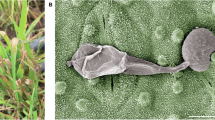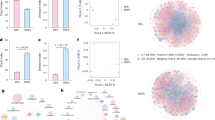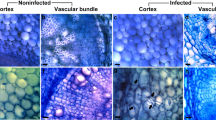ABSTRACT
Alpha-picolinic acid (PA), a metabolite of tryptophan and an inducer of apoptosis in the animal cell, has been reported to be a toxin produced by some of plant fungal pathogens and used in screening for disease resistant mutants. Here, we report that PA is an efficient apoptosis agent triggering cell death of hypersensitive-like response in planta. Confirmed by Fluorescence Activated Cell Sorter (FACS), rice suspension cells and leaves exhibited programmed cell death induced by PA. The PA-induced cell death was associated with the accumulation of reactive oxygen species that could be blocked by diphenylene iodonium chloride, indicating that the generation of reactive oxygen species was NADPH-oxidase dependent. We also demonstrated the induction of rice defense-related genes and subsequent resistant enhancement by PA against the rice blast fungus Magnaporthe grisea. Hence, it was concluded that the PA-stimulated defense response likely involves the onset of the hypersensitive response in rice, which also provides a simple eliciting tool for studying apoptosis in the plant cell.
Similar content being viewed by others
Login or create a free account to read this content
Gain free access to this article, as well as selected content from this journal and more on nature.com
or
References
Fernandez-Pol JA, Hamilton PD, Klos DJ . Essential viral and cellular zinc and iron containing metalloproteins as targets for novel antiviral and anticancer agents: implications for prevention and therapy of viral diseases and cancer. Anticancer research 2001; 21:931–58.
Fernandez-Pol JA, Johnson GS . Selective toxicity induced by picolinic acid in simian virus 40-transformed cells in tissue culture. Cancer Research 1977; 37:4276–9.
Fernandez-Pol JA, Bono Jr VH, Johnson GS . Control of growth by picolinic acid: differential response of normal and transformedlls. Proc Natl Acad Sci USA 1977; 74:2889–93.
Frumento G, Rotondo R, Tonetti M, Damonte G, Benatti U, Ferrara GB . Tryptophan-derived catabolites are responsible for inhibition of T and natural killer cell proliferation induced by indoleamine 2, 3-dioxygenase. J Exp Med 2002; 196:459–68
Varesio L, Clayton M, Blasi E, Ruffman R, Radzioch D . Picolinic acid, a catabolite of tryptophan, as the second signal in the activation of IFN-γ-primed macrophages. J Immunol 1990; 145:4265–71.
Pais TF, Appelberg R . Macrophage control of mycobacterial growth induced by picolinic acid is dependent on host cell apoptosis. J Immunol 2000; 164:389–97.
Ruffmann R, Schlick R, Chirigos MA, Budzynsky W, Varesio L . Antiproliferative activity of picolinic acid due to macrophage activation. Drugs Exptl Clin Res 1987; 10:607–14.
Bosco MC, Rapisarda A, Massazza S, Melillo G, Young H, Varesio L . The tryptophan catabolite picolinic acid selectively induces the chemokines macrophage inflammatory protein-1 alpha and -1 beta in macrophages. J Immunol 2000; 164:3283–91.
Rapella A, Negrioli A, Melillo G, Pastorino S, Varesio L, Bosco MC . Flavopiridol inhibits vascular endothelial growth factor production induced by hypoxia or picolinic acid in human neuroblastoma. Int J Cancer 2002; 99:658–64.
Fernandez-Pol JA, Klos DJ, Hamilton PD . Antiviral, cytotoxic and apoptotic activities of picolinic acid on human immunodeficiency virus-1 and human herpes simplex virus-2 infected cells. Anticancer research 2001; 21:3773–6.
Ogata S, Inoue K, Iwata K, Okumura K, Taguchi H . Apoptosis induced by picolinic acid-related compounds in HL-60 cells. Biosci Biotechnol Biochem 2001; 65:2337–9.
Greenberg JT . Programmed cell death in plant-pathogen interactions. Annu Rev Plant Physiol Plant Mol Biol 1997; 48:525–45.
De Jong AJ, Hoeberichts FA, Yakimova ET, Maximova E, Woltering EJ . Chemical-induced apoptotic cell death in tomato cells: involvement of caspase-like proteases. Planta 2000; 211:656–62.
Stein JC Hansen G . Mannose induces an endonuclease responsible for DNA laddering in plant cells. Plant Physiol 1999; 121:71–80.
Dixon RA, Harrison MJ, Lamb CJ . Early events in the activation of plant defense responses. Annu Rev Phytopathol 1994; 32:479–501.
Levine A, Tenhaken R, Dixon RA, Lamb CJ . Levine, A ., Tenhaken, R ., Dixon, R.A ., Lamb, C . (1994). H2O2 from the oxidative burst orchestrates the plant hypersensitive disease resistance response. Cell 1994; 79:583–93.
Lamb C, Dixon RA . The oxidative burst in plant disease resistance. Annu Rev Plant Physiol Plant Mol Biol 1997; 48:251–75.
Ryals JA, Neuenschwander UH, Willits MG, Molina A, Steiner HY, Hunt MD . Systemic acquired resistance. Plant Cell 1996; 8:1809–19.
Wäspi U, Schweizer P, Dudler R . Syringolin reprograms wheat to undergo hypersensitive cell death in a compatible interaction with powdery mildew. Plant Cell 2001; 13:153–61.
Koga J, Yamauchi T, Shimura M, Ogawa N, Oshimai K, Umemura K, Kikuchi M, Ogasawara N . Cerebrosides A and C, sphingolipid elicitors of hypersensitive cell death and phytoalexin accumulation in rice plants. J Biol Chem 1998; 273:31985–91.
Zimmerli L, Jakab G, Métraux JP, Mauch-Mani B . Potentiation of pathogen-specific defense mechanisms in Arabidopsis by β-aminobutyric acid. Proc Natl Acad Sci USA 2000; 97:12920–5.
Dowd PF . Relative inhibition of insect phenoloxidase by cyclic fungal metabolites from insect and plant pathogens. Nat Toxins 1999; 7:337–41.
Iwahashi H, Kawamori H, Fukushima K . Quinolinic acid, alpha-picolinic acid, fusaric acid, and 2,6-pyridinedicarboxylic acid enhance the Fenton reaction in phosphate buffer. Chem Biol Interact 1999; 118:201–15.
Chen Z, Chen QF . The application of α-picolinic acid on the screening of rice blast-resistant varieties. Acta Botanica Sinica 1993; 35:165–70.
Widiyanto SN, Mariani TS . In vitro selection and production of rice plantlets tolerant to the blast-toxin. Proc ITB 1995; 28 (suppl):19–27.
He Z, Dong H, Dong J, Li D Ronald P . Rice transcript Rim2 accumulates in response to Magnaporthe grisea and its predicted protein shares similarity with the proteins encoded by CACTA transposons. Mol Gen Genet 2000; 264:2–10.
He Z, Wang Z, Li J, Zhu Q, Lamb C, Ronald P, Chory J . Perception of brassinosteroids by the extracellular domain of the receptor kinase BRI1. Science 2000; 288:2360–3.
Peterhänsel C, Freialdenhoven A, Kurth J, Kolsch R, Schulze-Lefert P . Interaction analyses of genes required for resistance responses to powdery mildew in barley reveal distinct pathways leading to leaf cell death. Plant Cell 1997; 9:1397–409.
Kyozuka, J . & Shimamoto, K . In: Lindsey K. ed. Plant Tissue Culture Manual B2. Kluwer: Dordrecht 1991:1–17.
O'Brien I, Reutelingsperger C, Holdaway KM . Annexin-V and TUNEL use in monitoring the progression of apoptosis in plants. Cytometry 1997; 29:28–33.
Low PS, Heinstein PF . Elicitor stimulation of the defense response in cultured plant cells monitored by fluorescent dyes. Arch Biochem Biophys 1986; 249:472–9.
Thoudal-Christensen H, Zhang Z, Wei Y, Collinge DB . Subcellular localization of H2O2 in plants. H2O2 accumulation in papillae and hypersensitive response during the barley-powdery mildew interaction. Plant J 1997; 6:1187–94.
Reimmann C, Dudler R . cDNA cloning and sequence analysis of a pathogen-induced thaumatin-like protein from rice (Oryza sativa). Plant Physiol 1993; 101:1113–4.
Keller T, Damude HG, Werner D, Doerner P, Dixon RA, Lamb C . A plant homolog of the neutrophil NADPH oxidase gp91phox subunit gene encodes a plasma membrane protein with Ca2+ binding motifs. Plant Cell 1998; 10:255–66.
Valent B, Farrall L, Chumley FG . Magnaporthe grisea Genes for Pathogenicity and Virulence Identified Through a Series of Backcrosses. Genetics 1991; 127:87–101.
Alvarez ME, Pennell RI, Meijer PJ, Ishikawa A, Dixon RA, Lamb C . Reactive oxygen intermediates mediate a systemic signal network in the establishment of plant immunity. Cell 1998; 92:773–84.
Dorey S, Kopp M, Geoffroy P, Fritig B, Kauffmann S . Hydrogen peroxide from the oxidative burst is neither necessary nor sufficient for hypersensitive cell death induction, phenylalanine ammonia lyase stimulation, salicylic acid accumulation, or scopoletin consumption in cultured tobacco cells treated with elicitin. Plant Physiol 1999; 121:163–72.
Ryerson DE, Heath MC . Cleavage of nuclear DNA into oligonucleosomal fragments during cell death induced by fungal infection or by abiotic treatments. Plant Cell 1996; 8:393–402.
Tada Y, Hata S, Takata Y, Nakayashiki H, Tosa Y, Mayama S . Induction and signaling of an apoptotic response typified by DNA laddering in the defense response of oats to infection and elicitors. Mol Plant Microbe Interact 2001; 14:477–86.
Matsumura H, Nirasawa S, Kiba A, Urasaki N, Saitoh H, Ito M, Kawai-Yamada M, Uchimiya H, Terauchi R . Overexpression of Bax inhibitor suppresses the fungal elicitor-induced cell death in rice (Oryza sativa L.) cells. Plant J 2003; 33:425–34.
Acknowledgements
We are thankful to Dr. Dudler for providing the PIR2 probe, Dr. Werner for the rice gp91phox homolog probe, Prof. Sun for the blast culture, and Prof. Ma for measurement of PA. We are also grateful to Ms. Meng for FACS test and Prof. Wei for protoplast preparation. This research is supported by the National Natural Science Foudation of China (30125030) and the Chinese Academy of Sciences project (KSCX2-SW-301-02). Z. He is a fellow of the CAS “One-Hundred Talent” program.
Author information
Authors and Affiliations
Corresponding author
Rights and permissions
About this article
Cite this article
ZHANG, H., ZHANG, X., MAO, B. et al. Alpha-picolinic acid, a fungal toxin and mammal apoptosis-inducing agent, elicits hypersensitive-like response and enhances disease resistance in rice. Cell Res 14, 27–33 (2004). https://doi.org/10.1038/sj.cr.7290199
Received:
Revised:
Accepted:
Issue Date:
DOI: https://doi.org/10.1038/sj.cr.7290199
Keywords
This article is cited by
-
Artificial coat protein variants of cucumber mosaic virus induce enhanced resistance upon recognition by an R gene
Journal of General Plant Pathology (2023)
-
Temperature-dependent sugar accumulation in interspecific Capsicum F1 plants showing hybrid weakness
Journal of Plant Research (2021)
-
Kynurenine pathway as alternative biosynthetic pathway for fusaric acid in Fusarium oxysporum f.sp. cubense
Australasian Plant Pathology (2021)
-
Functional interplay of genes in prioritizing the responses of rice plants to fungal infection and abiotic stress
Acta Physiologiae Plantarum (2018)
-
Protoplasts in the analysis of early plant-pathogen interactions: current applications and perspectives
European Journal of Plant Pathology (2017)



